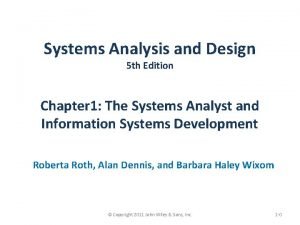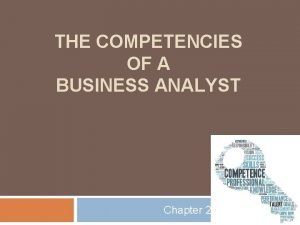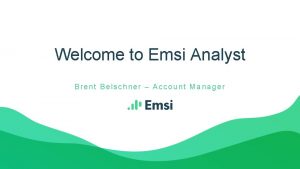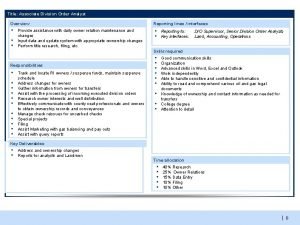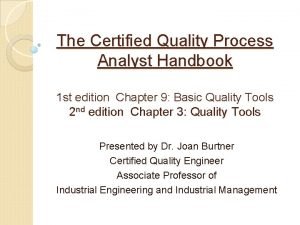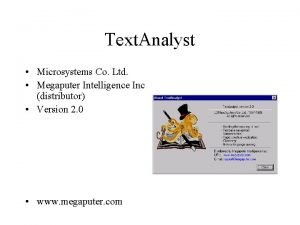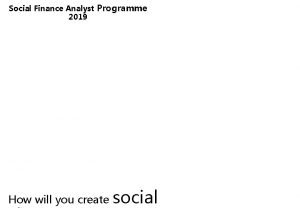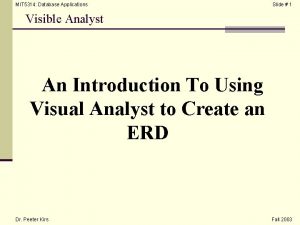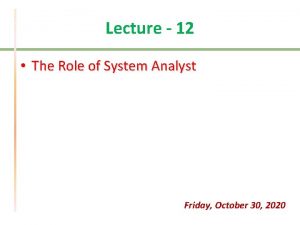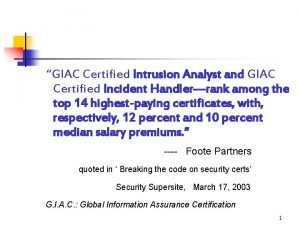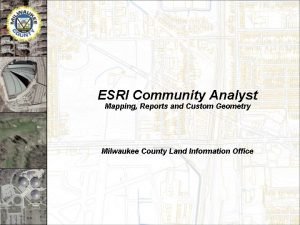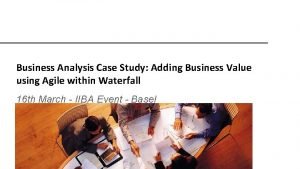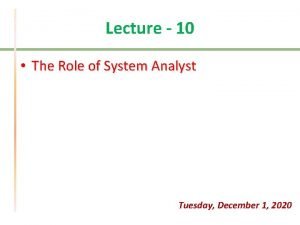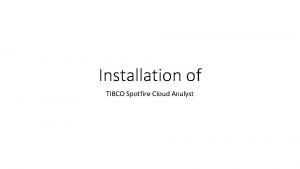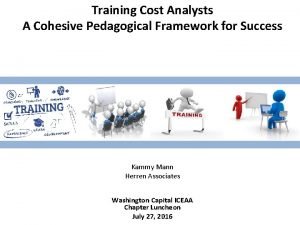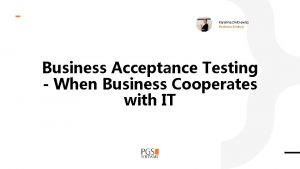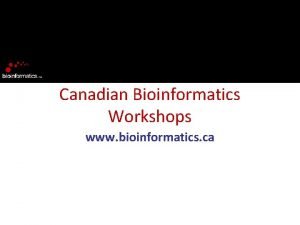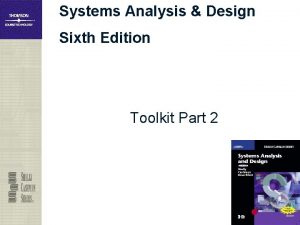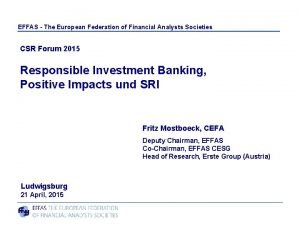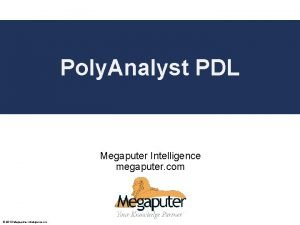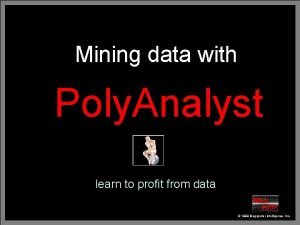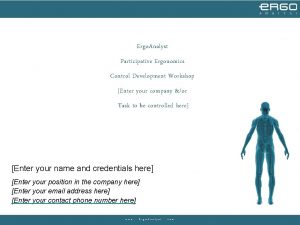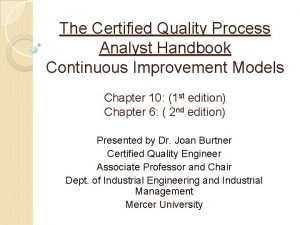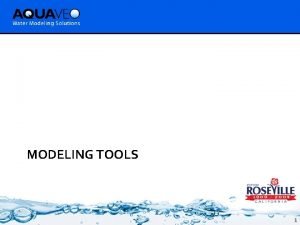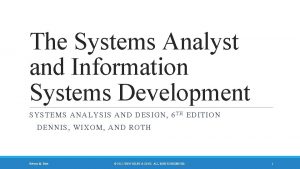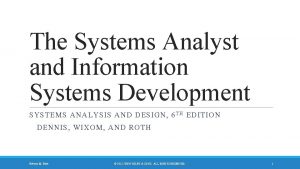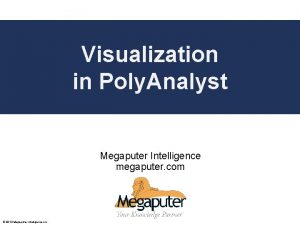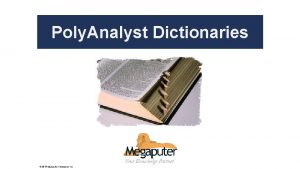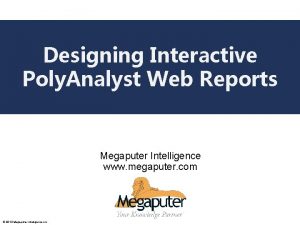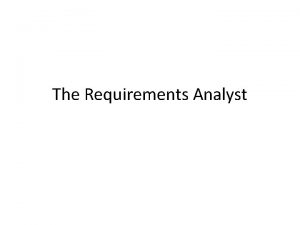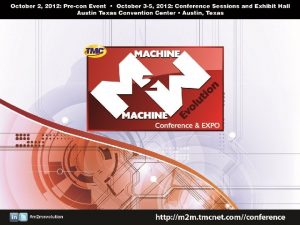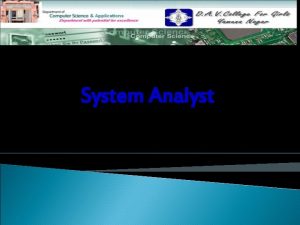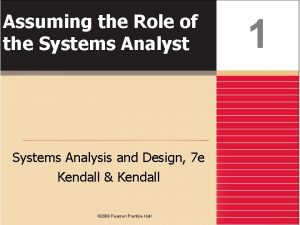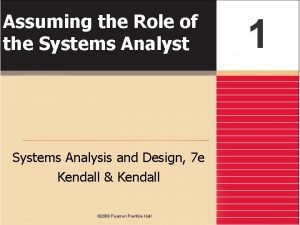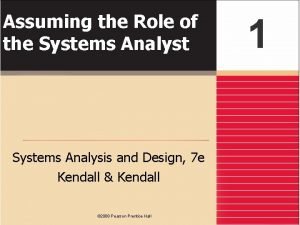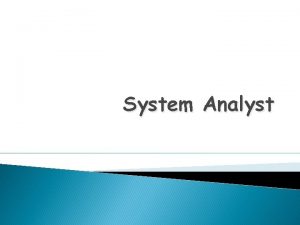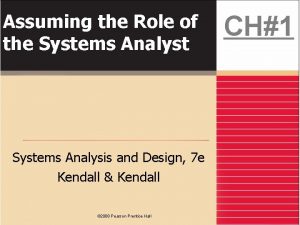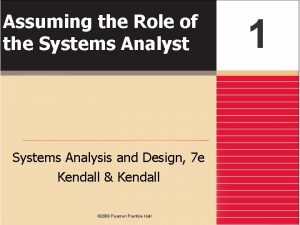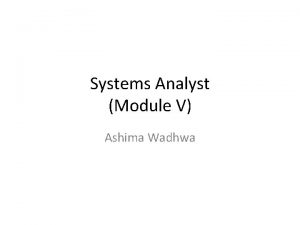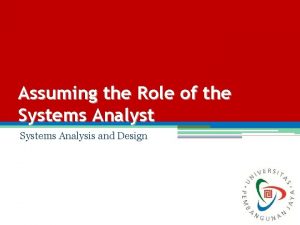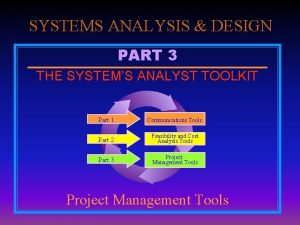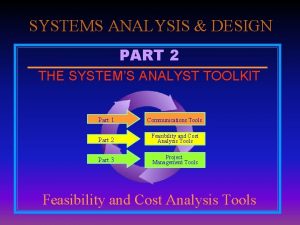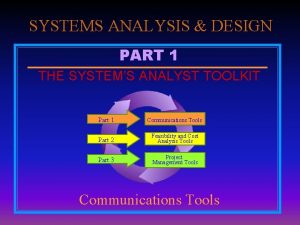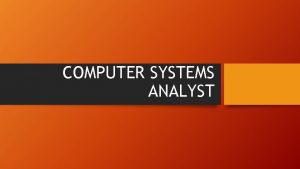Chapter 1 The Systems Analyst and Information Systems













































- Slides: 45

Chapter 1 The Systems Analyst and Information Systems Development SYSTEMS ANALYSIS AND DESIGN SEVENTH EDITION DENNIS, WIXOM, AND ROTH

Learning Objectives • Explain the systems analyst’s role information systems development. • Describe the basic systems development life cycle and its phases. • Explain how organizations identify IS development projects. • Explain the importance of linking the information system to business needs. • Be able to create a system request. • Describe technical, economic, and organizational feasibility assessment. • Be able to perform a feasibility analysis Copyright © 2019 John Wiley & Sons, Inc. 2

The Systems Analyst ROLE AND SKILLS Copyright © 2019 John Wiley & Sons, Inc. 3

Systems Analyst Role • Key role in developing information systems • Analyzing the business situation • Identifying opportunities for improvements • Designing an information system to implement the improvements Copyright © 2019 John Wiley & Sons, Inc. 4

Systems Analyst Roles • Interaction with an array of people • Technical specialists (DBAs, network admins, programmers) • Business people (users, managers, steering committee) • Others (vendors, consultants) • Variety of specialized roles • People-oriented: change management analyst, project management • Business-oriented: requirements analyst, business analyst • Technically-oriented: infrastructure analyst • Generalist: systems analyst Copyright © 2019 John Wiley & Sons, Inc. 5

What Do System Analysts Like About Their Work? • • • Challenge Technology Variety Constant Change Problem Solving Copyright © 2019 John Wiley & Sons, Inc. 6

What Do System Analysts Dislike About Their Work? • • • Management’s lack of communication/recognition End-user mistakes and demands Stress/pressure/burnout Ever-changing business technology Unrealistic deadlines Copyright © 2019 John Wiley & Sons, Inc. 7

Preparing for Your Career • • Working knowledge of information technology Computer programming experience & expertise General business knowledge Problem-solving skills Interpersonal communication skills Flexibility and adaptability Character and ethics Systems analysis & design skills Copyright © 2019 John Wiley & Sons, Inc. 8

The Systems Development Life Cycle THE OVERALL PROCESS OF SYSTEMS DEVELOPMENT Copyright © 2019 John Wiley & Sons, Inc. 9

How Do Systems Get Built? Systems Development Life Cycle (SDLC) • • Planning Analysis Design Implementation Copyright © 2019 John Wiley & Sons, Inc. 10

Planning Phase • Project Initiation • Prepare system request • Perform preliminary feasibility analysis • Set Up the Project • Project Plan, including work plan & staffing plan Copyright © 2019 John Wiley & Sons, Inc. 11

Analysis Phase • Determine Analysis Strategy • Study existing system and its problems • Collect and Analyze Requirements • Develop new system concept • Describe new system with analysis models • Prepare and Present System Proposal • Summarize results of the Analysis Phase • Go/No Go decision made by sponsor and steering committee Copyright © 2019 John Wiley & Sons, Inc. 12

Design Phase • Determine Design Strategy • Build / Buy / Outsource • Design system components • Architecture, interface, database, programs • Assemble design elements into System Specification • Present to steering committee • Go /No Go decision before entering final phase Copyright © 2019 John Wiley & Sons, Inc. 13

Implementation Phase • System Construction • Programming and testing • System Installation • Training • Conversion to new system • On-going system support Copyright © 2019 John Wiley & Sons, Inc. 14

Project Initiation HOW PROJECTS GET STARTED Copyright © 2019 John Wiley & Sons, Inc. 15

Where Do IS Projects Come From? • Fulfill a business need • • • Enable a business initiative or strategy Support a merger/acquisition Fix a “point of pain” Utilize a new technology Outgrowth of Business Process Management (BPM) Copyright © 2019 John Wiley & Sons, Inc. 16

What is BPM? (1 of 2) • Business Process Management: A methodology used by organizations to continuously improve end-to-end business processes • Internal and cross-organizational processes • Benefits include: • Enhanced process agility • Process alignment with industry “best practices” • Increased process efficiencies Copyright © 2019 John Wiley & Sons, Inc. 17

What is BPM? (2 of 2) • Four-step continuous cycle: • Define and map the steps in a business process, • Create ways to improve on steps in the process that add value, • Find ways to eliminate or consolidate steps in the process that don’t add value, • Create or adjust electronic workflows to match the improved process maps. Copyright © 2019 John Wiley & Sons, Inc. 18

BPM Identifies Business Needs • Business Process Automation • “Create or adjust electronic workflows to match the improved process maps” • Business Process Improvement • Study the business processes • Create new, redesigned processes to improve the process workflows, and/or • Utilize new technologies enabling new process structures • Business Process Reengineering • Total overhaul of work processes Copyright © 2019 John Wiley & Sons, Inc. 19

Do We Have a Project Yet? • Strong business need leads to a person or group stepping up as the Project Sponsor • • Driving force behind project Specifies overall business requirements Determines business value Formally requests a project via the System Request Copyright © 2019 John Wiley & Sons, Inc. 20

The Systems Request THE BUSINESS REASONS FOR THE NEW SYSTEM Copyright © 2019 John Wiley & Sons, Inc. 21

System Request • Describes business reasons for project • Defines system’s expected value • Force the sponsor to formalize his/her ideas • Provide a framework for collecting initial project information • Standardize information to be used by steering (approval) committee • Lists project’s key elements Copyright © 2019 John Wiley & Sons, Inc. 22

Elements of the Systems Request (1 of 3) • • • Project Sponsor Business Need Business Requirements Business Value Special Issues or Constraints Copyright © 2019 John Wiley & Sons, Inc. 23

Elements of the Systems Request (2 of 3) Element Description Examples Project Sponsor The person who initiates the project and who serves as the primary point of contact for the project on the business side Several members of the finance department Vice president of marketing CIO CEO Business Need The business-related reason for initiating the system Reach a new market segment Offer a capability to keep up with competitors Improve access to information Decrease product defects Streamline supply acquisition processes Business Requirements The new or enhanced business capabilities that the system will provide Provide on. Iine access to information Capture customer demographic information Include product search capabilities Produce performance reports Enhance online user support Copyright © 2019 John Wiley & Sons, Inc. 24

Elements of the Systems Request (3 of 3) Element Description Examples Business Value The benefits that the system will create for the organization 3% increase in sales 1% increase in market share Reduction in headcount by 5 FTEs $200, 000 cost savings from decreased supply costs $150, 000 savings from removal of outdated technology Special Issues or Constraints Issues that pertain to the approval committee’s decision Government-mandated deadline for May 30 System needed in time for the Christmas holiday season Top-level security clearance needed by project team to work with data FTE, full-time equivalent. Copyright © 2019 John Wiley & Sons, Inc. 25

Systems Request for Drōn. Teq Client Services System (1 of 2) System Request—Client Services Project Sponsor: Carmella Herrera, General Manager, Client Services Business Unit Business Need: This project has been initiated to create the capability of clients requesting drone flight service and data analysis through the company website. The capability is an essential element in the business model of the newly formed Client Services business unit. Business Requirements: Using this system from our company website, clients will be able to request specific drone flight services and data analysis. A request will be offered to any contracted Drōn. Teq drone pilots in the vicinity, who can submit bids during the bidding window. Once the bidding window closes, the pilot with the “winning“ bid will be assigned the request. Business Value: The Client Services business unit has been formed to enable clients who do not have a need for actual drone ownership to receive drone flight service and data analysis promptly and cost effectively. As a new business unit, we must estimate additional revenue from two streams: additional drone pilots who contract with Drōn. Teq and lease a drone; and clients who contract for specific drone flight service and data analysis. Copyright © 2019 John Wiley & Sons, Inc. 26

Systems Request for Drōn. Teq Client Services System (2 of 2) Conservative estimates of tangible value to the business unit include • $357, 500 in revenue from new pilot contracts and drone leases • $565, 000 in revenue from drone flight service and data analysis Special Issues or Constraints: The capabilities described in the Business Requirements are essential to the business model for the Client Services Business Unit. This project is necessary for the new business unit’s operations. Copyright © 2019 John Wiley & Sons, Inc. 27

Estimating Business Value (1 of 2) • Identify sources such as: • • Increased sales Decreased costs Reduced headcount Lower turnover • Assign values as initial estimates Copyright © 2019 John Wiley & Sons, Inc. 28

Estimating Business Value (2 of 2) Revenue Projections of Pilot Contracts and Drone Leases Revenue Projections of Client Requests for Drone Flight Service and Data Analysis High-level estimate (prob. = 25%) $500, 000 $700, 000 Medium-level estimate (prob. = 60%) $350, 000 $550, 000 Low-level estimate (prob. = 15%) $150, 000 $400, 000 Weighted average expected revenue $357, 500 $565, 000 Copyright © 2019 John Wiley & Sons, Inc. 29

Feasibility Analysis IS THIS PROJECT REALLY WORTH DOING…? CAN WE DO THIS PROJECT…? WILL THE ORGANIZATION ACCEPT THIS IF WE GO AHEAD…? Copyright © 2019 John Wiley & Sons, Inc. 30

Feasibility Analysis • Detailed business case for the project • Technical feasibility • Economic feasibility • Organizational feasibility • Compiled into a feasibility study • Critically important to reassess feasibility throughout the project Copyright © 2019 John Wiley & Sons, Inc. 31

Technical Feasibility: Can We Build It? • Sources of Technical Risk: • Users’ and analysts’ lack of familiarity with the business application area • Lack of familiarity with technology • Have we used it before? How new is it? • Project size • Number of people, time frame, distinct features • Compatibility with existing systems • Degree of integration required Copyright © 2019 John Wiley & Sons, Inc. 32

Economic Feasibility: Should We Build It? • • Identify costs and benefits Assign values to costs and benefits Determine cash flow Assess financial viability • Return on investment • Break even point • Net present value Copyright © 2019 John Wiley & Sons, Inc. 33

Costs and Benefits (1 of 2) • Include development and operational costs • Consider tangible and intangible benefits Copyright © 2019 John Wiley & Sons, Inc. 34

Costs and Benefits (2 of 2) Development Costs Operational Costs Development team salaries Software upgrades Consultant fees Software licensing fees Development training Hardware repair and upgrades Hardware and software Cloud storage fees Vendor installation Operational team salaries Office space and equipment Communications charges Data conversion costs User training Tangible Benefits Intangible Benefits Increased sales Increased market share Reductions in staff Increased brand recognition Reductions in inventory Higher-quality products Reductions in IT costs Improved customer service Better supplier prices Better supplier relations Copyright © 2019 John Wiley & Sons, Inc. 35

Cost-Benefit Analysis (1 of 3) • Discounted cash flow method preferred • NPV preferred Copyright © 2019 John Wiley & Sons, Inc. 36

Cost-Benefit Analysis (2 of 3) 2019 2020 2021 2022 2023 Total Benefits Increased sales Reduction in customer complaint callsa Reduced inventory costs 500, 000 70, 000 530, 000 70, 000 561, 800 70, 000 595, 508 70, 000 68, 000 Total Benefitsb 638, 000 668, 000 699, 800 733, 508 Present Value Total Benefits 601, 887 594, 518 587, 566 581, 007 2, 364, 978 Development Costs 2 servers @ $125, 000 Printer Software licenses Server software Development labor 250, 000 100, 000 34, 825 10, 945 1, 236, 525 0 0 0 0 0 Total Development Costs 1, 632, 295 0 0 50, 000 20, 000 115, 000 50, 000 20, 000 119, 600 50, 000 20, 000 124, 384 50, 000 20, 000 129, 359 185, 000 189, 600 194, 384 199, 359 Operational Costs Hardware Software Operational labor Total Operational Costs Copyright © 2019 John Wiley & Sons, Inc. 37

Cost-Benefit Analysis (3 of 3) 2019 2020 2021 2022 2023 Total Costs 1, 632, 295 185, 000 189, 600 194, 384 199, 359 Present Value Total Costs 1, 632, 295 174, 528 168, 743 163, 209 157, 911 NPV (PV Total Benefits − PV Total Costs ) Total 2, 296, 686 68, 292 a. Customer service values are based on reduced costs of handling customer complaint phone calls. b. An important yet intangible benefit will be the ability to offer services that our competitors currently offer. Copyright © 2019 John Wiley & Sons, Inc. 38

Organizational Feasibility: If We Build It, Will They Come? (1 of 2) • Strategic alignment • Are project goals aligned with business strategy? • Evaluate effect on various stakeholder groups • Strong and influential project champion? • Strong and widespread organizational management support? • Receptive / resistant system users? Copyright © 2019 John Wiley & Sons, Inc. 39

Organizational Feasibility: If We Build It, Will They Come? (2 of 2) • Strategic alignment • Close alignment with strategy increases the likelihood of success • Stakeholder groups can be influenced • Presentations describing and promoting benefits • Emphasizing personal benefits as well as organizational benefits • Prototypes help prove the system concept • Real user involvement throughout project Copyright © 2019 John Wiley & Sons, Inc. 40

Feasibility Assessment: Summing It Up (1 of 2) • All projects have feasibility risks • Our goal is to know the risks we face and the significance of those risks • Project Sponsor, Project Manager, and other team members need this awareness • Once risks are known, steps can be taken to mitigate the risks • For example, if unfamiliar with a new technology • Provide enough budget for training • Provide enough budget to hire consultants with expertise • Allow more schedule time to move up the learning curve • Use a methodology that incorporates experimentation Copyright © 2019 John Wiley & Sons, Inc. 41

Feasibility Assessment: Summing It Up (2 of 2) • Essential to continuously review and revise the feasibility assessment • How well are we managing the risks we previously identified? Are adjustments needed? • Risk is being managed • Risk is not well managed and needs further attention • Are there any new risks that have appeared? • If so, what are the actions needed to address those risks? • Budgetary and schedule effect? Copyright © 2019 John Wiley & Sons, Inc. 42

After reading and studying this chapter, you should be able to: (1 of 2) • Explain the role of the systems analyst in the process of developing IS. • Discuss the skills needed to be a successful systems analyst. • List and explain the four primary phases of the SDLC. • Explain the ways that projects are identified and initiated. • Explain why it is important to ensure that a proposed IS will add value to the organization. • Describe the purpose of the systems request and explain the contents of its four main sections. Copyright © 2019 John Wiley & Sons, Inc. 43

After reading and studying this chapter, you should be able to: (2 of 2) • Be able to create a systems request for a proposed project. • Discuss the purpose of the feasibility study. • Describe the issues that are considered when evaluating a project’s technical feasibility. • Be able to develop an economic feasibility assessment for a project. • Understand evaluate the organizational feasibility of a project. Copyright © 2019 John Wiley & Sons, Inc. 44

Copyright © 2019 John Wiley & Sons, Inc. All rights reserved. Reproduction or translation of this work beyond that permitted in Section 117 of the 1976 United States Act without the express written permission of the copyright owner is unlawful. Request for further information should be addressed to the Permissions Department, John Wiley & Sons, Inc. The purchaser may make back-up copies for his/her own use only and not for distribution or resale. The Publisher assumes no responsibility for errors, omissions, or damages, caused by the use of these programs or from the use of the information contained herein. Copyright © 2019 John Wiley & Sons, Inc. 45
 Systems analyst career progression
Systems analyst career progression Business analyst competency matrix
Business analyst competency matrix Chapter 4 ethical and social issues in information systems
Chapter 4 ethical and social issues in information systems Chapter 4 ethical and social issues in information systems
Chapter 4 ethical and social issues in information systems Chapter 3 information systems organizations and strategy
Chapter 3 information systems organizations and strategy Tami teitter
Tami teitter Division order analyst salary
Division order analyst salary Certified quality process analyst
Certified quality process analyst Megaputer competitors
Megaputer competitors Subsurface analyst
Subsurface analyst Social finance analyst programme
Social finance analyst programme Shell lube analyst
Shell lube analyst Visible analyst
Visible analyst Multifaceted role of system analyst
Multifaceted role of system analyst What is an associate director
What is an associate director Certified intrusion analyst
Certified intrusion analyst Community analyst esri
Community analyst esri Talent analyst emsi
Talent analyst emsi Case study business analyst
Case study business analyst T shaped professional business analyst
T shaped professional business analyst Interpersonal skills of system analyst
Interpersonal skills of system analyst Spotfire crack
Spotfire crack Technical skills of system analyst
Technical skills of system analyst Cost analyst
Cost analyst Role of system analyst
Role of system analyst Morteza anvari
Morteza anvari Tony a data analyst for a major casino
Tony a data analyst for a major casino Business acceptance analyst
Business acceptance analyst Ifs business analyst
Ifs business analyst Metabo analyst
Metabo analyst Visible analyst case tool
Visible analyst case tool European federation of financial analysts societies
European federation of financial analysts societies The collection analyst
The collection analyst Poly analyst
Poly analyst Poly analyst
Poly analyst Ergoanalyst
Ergoanalyst Certified quality process analyst
Certified quality process analyst Modflow analyst
Modflow analyst Gms groundwater
Gms groundwater Deloitte forensic technology
Deloitte forensic technology Poly analyst
Poly analyst Hình ảnh bộ gõ cơ thể búng tay
Hình ảnh bộ gõ cơ thể búng tay Slidetodoc
Slidetodoc Bổ thể
Bổ thể Tỉ lệ cơ thể trẻ em
Tỉ lệ cơ thể trẻ em Gấu đi như thế nào
Gấu đi như thế nào
